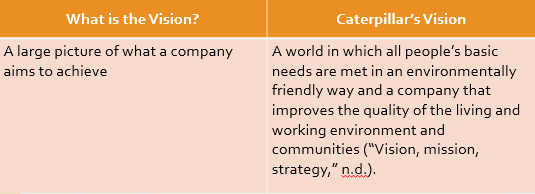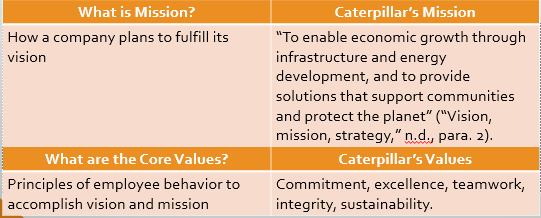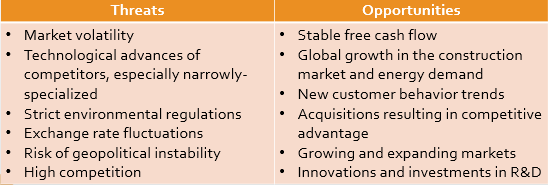Caterpillar Inc.’s Vision
Caterpillar Inc. is a large US-based company designing, manufacturing, marketing, and selling heavy equipment mainly for construction and mining industries. Caterpillar’s vision reflects the company’s goals and aspirations, as well as its difference from competitors, that is, its orientation toward providing environmentally sustainable solutions. Yet, the company’s mission statement has one drawback – it is too long. The vision statement presented on the slide is a shortened version; the original version is even longer. It makes it difficult for customers to memorize Caterpillar’s vision statement.
Caterpillar’s Vision
A world in which all people’s basic needs are met in an environmentally friendly way and a company that improves the quality of the living and working environment and communities (“Vision, mission, strategy,” n.d.).
What is the Vision?
A large picture of what a company aims to achieve

Caterpillar’s Mission and Core Values
Caterpillar’s mission statement contains the company’s plan on how to accomplish its vision. It also informs customers about the company’s competencies by stating that Caterpillar is competent in developing infrastructure and the energy industry. In addition, the mission statement addresses customer needs, which include economic growth, support for communities, and environmental protection. The firm’s value statement contains core values relevant to the organization’s vision and mission and outlines the main principles of Caterpillar’s employees’ behavior.

Recommended Changes to Caterpillar Inc.’s Vision
The evaluation of the company’s vision, mission, and values statements showed no significant issues with Caterpillar’s vision. Yet, one recommendation regarding the vision statement can be made. Caterpillar may think of the ways to make its vision statement shorter and more memorable so that it easily comes to customers’ minds when they hear the company’s name. The mission statement needs no improvements because it is already concise and reflects the company’s goals and competencies. Caterpillar’s core values also do not need to be changed. However, the company may want to revise its core values by interviewing its employees at different levels to find out the shared values and what they mean to them.
Caterpillar Inc.’s Strengths and Competitive Advantages
Caterpillar conducts its business in a highly competitive environment; therefore, having a strong competitive advantage is crucial for the company’s success. The organization’s main competitive advantages are high product quality and large product portfolio. Caterpillar (2019) also emphasizes the role of its superior operational performance, strong financial position, and global dealer network in its business performance. The company’s application of the Operating & Execution Model is another strength since it allows for allocating resources to the most profitable business areas. Investments in R&D enable the company to develop new products to better satisfy customer needs. Finally, Caterpillar is distinguished from its competitors by good customer service, offering its clients customer-oriented solutions throughout the product life cycle.
Caterpillar Inc.’s Weaknesses and Competitive Disadvantages
In terms of product quality, Caterpillar is among the best-performing companies; however, the organization has several weaknesses in other areas. One of its competitive disadvantages is prices in foreign markets. According to Caterpillar (2019), the prices of its products in foreign markets may be subject to exchange rate fluctuations; as a result, Caterpillar’s prices may become too high and thus uncompetitive in foreign markets. Other weaknesses include legal proceedings because of environmental issues and debt agreements, both of which may harm the company’s financial situation. Apart from this, in 2019, Caterpillar experienced a 2% decline in its sales and revenues (Caterpillar, 2019). It may be evidence of problems with the company’s cost structure.
Caterpillar’s External Environment: Threats and Opportunities
Before giving recommendations to Caterpillar on how it can improve its business performance, it is also necessary to consider its external environment to identify threats to be addressed and opportunities to make use of. As for threats, Caterpillar should pay attention to competitors’ technological developments since they can outperform Caterpillar’s products and weaken its market position. The company can address these threats using its opportunities, such as exploring new consumer behavior trends and investing in R&D to develop new competitive products.

Recommended Operational Changes
Caterpillar can make some operational changes to achieve its goal of sustainable growth and market expansion. The company should use its competencies in product development and investments in R&D to extend its product line. To fulfill this goal, it should hire several new engineers to develop new products. It would allow the company to improve its competitive position and address the threat of competitors’ technological advances.
The company should also reduce its greenhouse gas emissions and increase the use of alternative sources of energy to make them constitute 20% of overall energy use. These measures will help Caterpillar to address the issue of strict environmental regulations and legal proceedings, as well as accomplish Caterpillar’s vision of itself as a sustainable company.
Plan to Measure the Effectiveness of the Proposed Changes
Companies can measure the effectiveness of their operational plans in many ways. Some of the ways include financial reports and quality measures, such as defect rates (Principles of management, 2019). For the proposed operational changes, Caterpillar can use such performance measures as the number of new products launched, the quantity of greenhouse gas emissions, and the percentage of the alternative energy sources in the total energy consumption. The measures should be reported regularly for the company to detect any problems early and improve the plan.
Caterpillar Inc.’s Global Strategy
Caterpillar’s global strategy can be characterized as transnational because it acts as a domestic company in foreign markets and adds local features to its products. Caterpillar also experiences a high pressure for cost reduction because it competes with other market players not only on product quality and customer service but also on price. One way Caterpillar reduces costs is by having manufacturing plants in different regions, which allows for decreasing costs of transportation. Caterpillar significantly benefits from its highly-developed global dealer network. It builds strong relationships with its dealers by offering them favorable terms of partnership and providing them with training.
Operational Changes to Improve Global Strategy
Since Caterpillar’s strategic goal is long-term growth and expansion, it should consider ways of expanding its business. For example, it can expand the manufacturing capacity of one of its existing plants, or it can open a manufacturing plant in a new location. It would allow the company to produce more products to meet the current demand. Earlier, it was mentioned that Caterpillar is faced with the risk of exchange rate fluctuations in foreign markets. To address this issue, the company should use more local resources in regions outside the US and trade using the local currency. It would make exchange rate fluctuations have less influence on Caterpillar’s operations.
Plan to Measure the Effectiveness of the Proposed Change
To measure the effectiveness of its plan on business expansion, Caterpillar should assess the manufacturing capacity of its plants and report output volumes. An increase in these measures will indicate the effectiveness of the proposed changes. As for the issue with exchange rate fluctuations, the company should assess its foreign exchange risks to identify problematic regions. Upon assessing the risks, the company will be able to improve the plan by choosing the most appropriate strategy for addressing the risk of exchange rate fluctuations. Overall, Caterpillar has already been successful in implementing its global strategy, and the proposed changes may contribute to its further expansion and strengthen its position in the global market.
Conclusion: Summary of Recommendations
To sum up, Caterpillar implements effective strategies for conducting business in its industry, so no major operational changes are needed for the company. Yet, some improvements can be suggested to help the company maintain its competitive position and ensure its further growth and expansion. The company may improve its vision by making it more memorable for its customers.
Furthermore, Caterpillar should allocate resources for developing new products that would provide it with a competitive advantage. Reducing GHG and increasing the use of alternative sources of energy will help the company to achieve its strategic goal of being an environmentally sustainable company. Finally, expanding the company’s manufacturing capacity and addressing the risk of foreign exchange fluctuations will improve the company’s global business performance.
References
Caterpillar. (2019). 2019 annual report: Executing our strategy. Web.
Principles of management. (2019). Rice University.
Rothaermel, F. (2016). Strategic management: Concepts (3rd ed.). McGraw-Hill Education.
Vision, mission, strategy, & principles. (n.d.). Caterpillar. Web.
